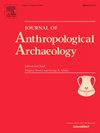A reappraisal of interaction spheres
IF 2.2
1区 社会学
Q1 ANTHROPOLOGY
引用次数: 0
Abstract
Migration and diffusion are universal phenomena that fell out of favor in American archaeology during the processulist turn. David Anthony’s 1990 defense spurred renewed interest in migration as a structured behavior worthy of serious analysis; yet we continue to dismiss diffusion as a nonexplanatory cultural force that is both difficult to identify in the material record and overemphasizes the roles that internal invention and external stimuli play in the process of culture change. The interaction sphere concept offers us an established theoretical means of rehabilitating diffusion and integrating the other microsocial theories, frameworks, and perspectives that have since proliferated. This article outlines seven key tenets: four drawn from the formative Eastern Woodlands literature, two illustrated in an indigenous North American map making tradition, and a final tenet observed in the application of the concept to the complex issue of Plaquemine cultural emergence in the Lower Mississippi Valley. Without acknowledging the vital role that intellectual and material exchange plays in the process of continuity, innovation, and change, we continue to ignore the many ways in which interaction shaped history. I advocate for a return to the concept of interaction spheres for the same reasons originally promoted by Joseph Caldwell: it contributes a new understanding of the archaeology, it facilitates comparisons between different networks of extra-regional exchange, and it correlates well with various other theoretical models.
对相互作用领域的重新评价
迁移和扩散是一种普遍现象,但在美国考古学转向过程主义的过程中,这种现象不再受青睐。大卫·安东尼1990年的辩护重新激起了人们对移民作为一种值得认真分析的结构化行为的兴趣;然而,我们继续将传播视为一种难以解释的文化力量,这种力量既难以在物质记录中识别,又过分强调内部发明和外部刺激在文化变革过程中所起的作用。互动领域的概念为我们提供了一种既定的理论手段来恢复扩散和整合其他微观社会理论、框架和观点,这些理论、框架和观点已经扩散。本文概述了七个关键原则:四个来自形成性的东部伍德兰文学,两个来自北美土著地图制作传统,最后一个原则是在将这一概念应用于密西西比河谷下游普拉克明文化出现的复杂问题时观察到的。如果不承认智力和物质交流在延续、创新和变革过程中所起的重要作用,我们就会继续忽视互动塑造历史的许多方式。我主张回归互动领域的概念,原因与约瑟夫·考德威尔(Joseph Caldwell)最初提出的原因相同:它有助于对考古学的新理解,它有助于比较不同的区域外交换网络,并且它与各种其他理论模型密切相关。
本文章由计算机程序翻译,如有差异,请以英文原文为准。
求助全文
约1分钟内获得全文
求助全文
来源期刊

Journal of Anthropological Archaeology
Multiple-
CiteScore
4.00
自引率
11.10%
发文量
64
期刊介绍:
An innovative, international publication, the Journal of Anthropological Archaeology is devoted to the development of theory and, in a broad sense, methodology for the systematic and rigorous understanding of the organization, operation, and evolution of human societies. The discipline served by the journal is characterized by its goals and approach, not by geographical or temporal bounds. The data utilized or treated range from the earliest archaeological evidence for the emergence of human culture to historically documented societies and the contemporary observations of the ethnographer, ethnoarchaeologist, sociologist, or geographer. These subjects appear in the journal as examples of cultural organization, operation, and evolution, not as specific historical phenomena.
 求助内容:
求助内容: 应助结果提醒方式:
应助结果提醒方式:


